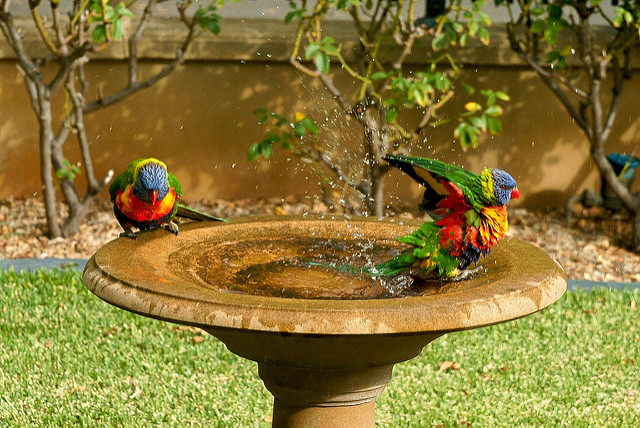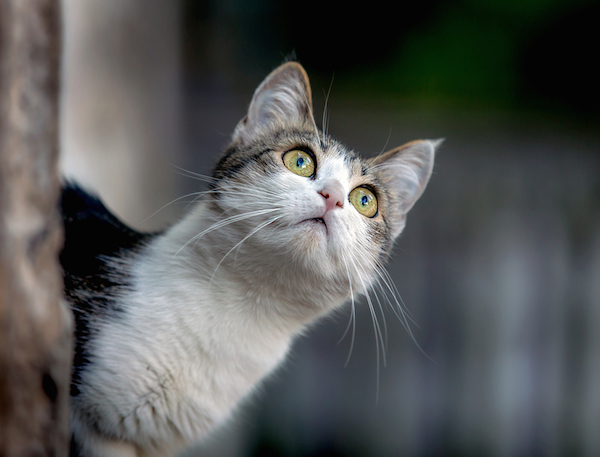Can you cut 1 Tonne of carbon pollution out of your life?
Take the challengeClimate change is a major contributor to biodiversity loss, with bird species being affected in a number of ways. Urbanisation also plays a role, with natural habitats transforming into landscapes where buildings, concrete and lawn abound.
For a small number of species these habitats are ideal however, for many bird species, populations are declining.
Like all living things, birds play a crucial role in our ecosystem and it is important for us to support their survival. Not only do they keep other animals in the food chain in check (including garden pests), they also play a role in pollination.
We can all make a contribution to supporting our indigenous birds through educating ourselves and others, and by actively providing for their needs.
What do birds need?
There are 5 basic requirements:
- safety
- shelter
- food
- water
- nesting materials and sites

image: Steve Austin (Flickr)
To feed or not to feed
Watching birds chatter and eating food that we have provided for them is an aesthetically beautiful experience but it is not healthy for birds. Organisations such as WIRES recommend we do not feed them for a number of reasons.
These include:
- problems associated with dietary imbalances and deficiencies
- the spread of diseases
- increased aggression between birds
- birds becoming dependant on humans and less capable of feeding themselves
- normally nomadic species becoming sedentary
- in the case of ducks, bread can ferment in the gut causing bacterial infections
The balance of species can also be affected, with birds that adapt well to the urban environment increasing at the expense of other species. This is thought to be the case with the Rainbow lorikeet whose population is increasing while the Scaly Breasted lorikeet is struggling to survive.
If you must feed birds, make it an occasional treat and keep the area clean to reduce some of the risks of diseases being passed on.

image: Cazz (Flickr)
Create a native garden
A better option is to provide food for birds through planting a native garden. The other advantage of doing this is that you will attract more diversity to your garden.
Birds can be nectar feeders, seed-eaters, fruit eaters, insect eaters, or meat eaters so try and provide a range of local plant species. Consider ground covers, native grasses, different densities of shrubs and even small trees.
If you are short of garden space, try growing some natives in pots, hanging baskets and common areas.
Connect with your neighbours and local council
Work with your neighbours to create a wildlife corridor and get in touch with your council and ask them about creating more habitats for birdlife in your area. Many councils have native plant nurseries where you can buy discounted plants and some even give out tubestock plants to residents each year.

Get to know your local birds
Local councils and libraries are wonderful resources for finding out information on native birds in your area. You might also enjoy websites such as Birds in Backyards and bird apps for your phone that include both visual identification and bird calls.

Add a bird bath
Birds require a water source for both drinking and bathing and this is particularly important during heatwaves. It's a great idea to put out a couple of extras during this time if you can.
You can install a pedestal bird bath, hang a saucer from a tree or even just place a saucer on the ground. Find an area with some dappled shade and if possible provide some protection from predators. It's important to replace the water daily and to keep the bird bath clean.

Provide nesting materials or a nest box
Different species of birds build their nests in tree hollows, structures in branches and even on the ground. By making building materials available, you can ensure that birds will have the essentials to make a nest. This can include leaving some leaf litter, bark and grass in your garden, and even some spider web which is used by many birds as a binding substance in their nest building.
Installing a nestbox is another option, as these can be used by birds that normally build nests in tree hollows that are becoming scarce in urban areas.
Tailor the size of your box to the species you are trying to attract. Small parrots are a good option. Face the entry away from prevailing winds and maintain your box to ensure insects don't move in.
Here is a great link to 13 DIY nest box plans from Birds In Backyards.
Avoid using pesticides and insecticides
Weeding can be a tough job but to protect native wildlife it's important to avoid using pesticides that may contaminate the birds' food.

image: HugelKultur Blog
Use wildlife friendly netting
Birds and other animals can easily get caught and injured in regular netting used to protect fruit trees. Wildlife-friendly netting has holes no greater than 0.5cm. Another option is to bag fruit individually.

Provide protection from pets
If you have a dog or cat ensure you get it de-sexed and keep it under control. Keeping your cat inside at night is particularly important. Also provide lots of hiding places for birds that are difficult for your pet to get to.
We can all play an important role in supporting conservation and enjoy the beauty of our stunning Australian birdlife at the same time.
Read this next: 10 ways to support Australian native bees in your backyard
We're in a climate emergency and it's going to take all of us to get out of it. That's why 1 Million Women is building a global community of women committed to fighting climate change with our daily actions. To join the (free) movement just click the button below!

